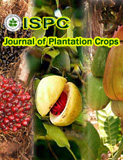Incorporation of coconut milk residue in pasta: Influence on cooking quality, sensory and physical properties
DOI:
https://doi.org/10.25081/jpc.2021.v49.i2.7259Abstract
A study was conducted to explore the potentiality of coconut milk residue (CMR) for cold extrusion (pasta preparation). Proximate analysis revealed that coconut milk residue is a rich source of crude fibre (24.03%) in addition to crude fat (41.55%), crude protein (5%), total carbohydrates (26.24%) and ash content (0.97%) at 2.23 per cent moisture. The effect of coconut milk residue upon replacing durum wheat semolina on cooking qualities, colour parameters, textural property and overall sensory acceptability of pasta samples were evaluated. Incorporation of coconut milk residue significantly influenced the observed parameters (P<0.01). Cooking time was unaffected by incorporating milk residue up to 10 per cent (P<0.05). Though the addition of residue increased the gruel loss (0.84 to 1.34%), the per cent loss was below the technologically acceptable limit (<8%). A similar effect was visualized in water absorption. Conversely, the firmness gets reduced with an increased concentration of coconut milk residue beyond 10 per cent. Pasta with 5 per cent and 10 per cent coconut milk residue were accepted as that of control by the sensory panel. Free fatty acid content was not affected by the period of storage (P>0.05). Thus, the study recommends incorporating 10 per cent coconut milk residue in durum wheat semolina for pasta preparation. Moreover, the entrepreneurs engaged in the coconut milk/milk powder and virgin coconut oil industry would be benefitted by adopting this venture, wherein they would be able to fetch huge additional income by placing their residue product on an upgraded fast-moving consumer good (FMCG) value chain.
Downloads
Published
How to Cite
Issue
Section
Copyright (c) 2021 Journal of Plantation Crops

This work is licensed under a Creative Commons Attribution 4.0 International License.







 .
.